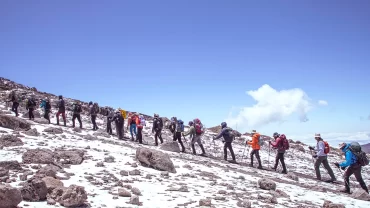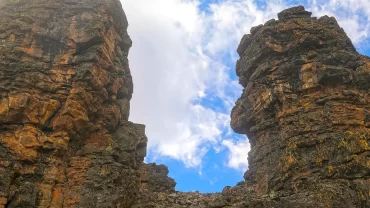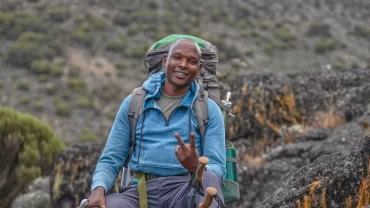How to Adapt to High Altitude Safely
Climbing Mount Kilimanjaro is an extraordinary adventure, but the journey to the summit presents unique physiological challenges. One of the most critical factors in a successful climb is acclimatization on Kilimanjaro—the process by which your body adapts to high-altitude, low-oxygen environments. Understanding acclimatization and following the right strategies can make the difference between a successful summit and altitude sickness.
At Dismass Kilimanjaro Experience (DKE), we prioritize gradual ascent, strategic rest stops, and expert guidance to help climbers acclimate safely. This guide explains how your body adjusts to high altitude, the symptoms of altitude sickness, and the best practices for acclimatization during your climb.
1. What is Acclimatization and Why is it Important?
As you ascend Kilimanjaro, the air becomes thinner, meaning there is less oxygen available for your body to function normally. To cope with this, your body initiates a series of adjustments to adapt to the reduced oxygen supply:
- Increased breathing rate to take in more oxygen.
- Elevated heart rate to deliver oxygen-rich blood to your muscles and organs.
- Production of more red blood cells to improve oxygen transportation.
Acclimatization reduces the risk of altitude sickness and improves your body’s ability to function efficiently in high-altitude conditions. It is a gradual process, and rushing the climb increases the likelihood of severe altitude-related complications.
2. Understanding Altitude Sickness: Symptoms & Risks
Altitude sickness, also known as Acute Mountain Sickness (AMS), occurs when your body struggles to adapt to the lower oxygen levels at high elevations. Symptoms range from mild discomfort to life-threatening conditions like high-altitude pulmonary edema (HAPE) or high-altitude cerebral edema (HACE).
Common Symptoms of Mild AMS:
- Headache
- Nausea or dizziness
- Shortness of breath
- Loss of appetite
- Fatigue or trouble sleeping
Severe Altitude Sickness Symptoms:
- Persistent vomiting
- Confusion or difficulty walking
- Fluid buildup in the lungs (HAPE) – symptoms include breathlessness, chest tightness, and a dry cough.
- Brain swelling (HACE) – symptoms include disorientation, loss of coordination, and severe headaches.
If you or someone in your group experiences these severe symptoms, immediate descent and medical attention are crucial.
For more on how climbers overcome challenges on Kilimanjaro, read: Inspiring Kilimanjaro Success Stories from Real Climbers.
3. Proven Acclimatization Strategies on Kilimanjaro
1. Follow the “Climb High, Sleep Low” Rule
The most effective acclimatization strategy is ascending gradually and sleeping at a slightly lower elevation than the highest point reached during the day. This helps the body adjust to reduced oxygen levels while minimizing the risk of altitude sickness.
2. Choose a Route with Built-in Acclimatization Days
Certain Kilimanjaro routes offer a more gradual ascent, improving acclimatization success rates. The best routes include:
- Lemosho Route – An 8-day trek with high acclimatization success.
- Machame Route – A 7-day trek known for its scenic landscapes and gradual elevation gain.
- Northern Circuit – A 9-day route offering the best acclimatization advantage.
For a guide on selecting the best route for your climb, read: How to Choose the Best Kilimanjaro Route for Your Adventure.
3. Stay Hydrated and Maintain Nutrition
Dehydration worsens altitude sickness symptoms and affects your body’s ability to adjust. Drink 3-4 liters of water per day, and eat high-energy, easily digestible meals packed with carbohydrates and proteins.
4. Take Your Time – Slow and Steady Wins the Race
Pacing is key. Rushing to higher elevations increases altitude sickness risk. Our guides follow the Swahili philosophy of “Pole Pole” (slowly, slowly), ensuring a steady, comfortable ascent.
5. Consider Acetazolamide (Diamox) for Prevention
Diamox is a prescription medication that helps speed up acclimatization by promoting faster breathing, aiding oxygen absorption. Consult with your doctor to see if it is suitable for you.
4. How DKE Ensures Safe Acclimatization on Kilimanjaro
At Dismass Kilimanjaro Experience, safety is our priority. Our experienced guides are trained to monitor climbers for altitude sickness symptoms and provide necessary support. Here’s how we ensure proper acclimatization:
- Gradual Itineraries: Our trek schedules incorporate acclimatization days and follow the “climb high, sleep low” principle.
- Health Monitoring: Our guides use pulse oximeters to measure oxygen saturation levels daily.
- Emergency Equipment: Every team carries oxygen tanks, a Portable Altitude Chamber (PAC), and a satellite phone for emergencies.
- Immediate Response Protocols: If a climber experiences severe altitude sickness, we arrange an immediate descent and evacuation if necessary.
To learn more about how we maintain safety on the mountain, read: How Dismass Kilimanjaro Supports Sustainable Travel.
5. High-Altitude Safety: Tips and Precautions
Essential Do’s & Don’ts for Acclimatization
✅ Do’s:
- Drink plenty of water – Hydration is crucial.
- Eat high-energy meals – Proper nutrition supports endurance.
- Listen to your body – Rest when needed and communicate any symptoms.
- Follow a gradual ascent schedule – Avoid rapid altitude gains.
- Sleep well – Rest is essential for recovery and adaptation.
❌ Don’ts:
- Avoid alcohol and sedatives – They suppress breathing and worsen symptoms.
- Don’t skip acclimatization hikes – These are crucial for your success.
- Avoid overexertion – Keep a steady, relaxed pace.
By following these strategies, you maximize your chance of a successful Kilimanjaro summit while minimizing health risks.
Final Thoughts: Climbing High, Staying Strong
Acclimatization is the key to conquering Kilimanjaro safely. By choosing the right route, following a gradual ascent, staying hydrated, and listening to your body’s signals, you set yourself up for a successful and memorable summit experience.
At Dismass Kilimanjaro Experience, our expert guides ensure that you acclimate effectively, stay safe, and enjoy the adventure of a lifetime.
For further preparation, explore:
- Life Above the Clouds: What to Expect at Kilimanjaro’s Summit
- The Ultimate Tanzania Adventure Packing List
- The Best Time to Go on a Safari in Tanzania
Ready to take the first step toward your Kilimanjaro summit? Contact us today and start your journey with expert guidance!





Comment (0)